Linares (Chile)
Linares (officially founded as Villa San Ambrosio de Linares) is a commune and city in central Chile, capital of the province of Linares. It is an agricultural, agro-industrial, communications and services center in the Maule Region. It was the capital of the former province of Linares, with the rank of current region.
It is part of Electoral District No. 18 (Deputies), and belongs to the 8th Senatorial District (Maule Region).
Toponymy
The city of Linares receives its name from Don Francisco Espinoza Muñoz de la Mata Linares, who served as Mayor of Concepción at the time the town was founded. Originally It was going to be called San Francisco de Linares, but De la Mata Linares himself did not want to, after which it was changed to San Ambrosio de Linares, in honor of Ambrosio O&# 39;Higgins, Governor of Chile at that time.
History

Linares or also nicknamed 'Enchanting City', was founded on May 23, 1794 by order of the future viceroy of Peru Ambrosio O'Higgins, who at that time governed the Captaincy General of Chile, and that he was the father of Bernardo O'Higgins. At the same time, Francisco de la Matta Linares ruled in the Concepción Municipality, in whose honor the new town was named after him. The original name of the city was Villa San Ambrosio de Linares. An attempt had previously been made to found the town of San Javier de Bellavista without success in 1755 and 1768.
To build the new town, 1,500 hectares of the 5,100-hectare Pilocoyán Estate, property of Mrs. Ángela Vásquez Tapia, widow of Aceytón first, and Barros later, were expropriated. Linares was located, in this way, on the royal road that crossed the Longitudinal Valley, coming from Santiago.
The city was the scene of the first act of arms in the long road that would finally lead to the independence of Chile, with the taking of the square, on April 6, 1813, by General Bernardo O'Higgins Riquelme.
On April 23, 1873, it became the capital of the newly created province of the same name, split from the Province of Maule.
On May 2, 1875, the high school today known as "Liceo Valentín Letelier" was created, where many of those who are today considered illustrious children of Linares were educated, such as the former president of the Republic Carlos Ibáñez of the Field; the poet Max Jara, the historian and journalist Julio Chacón del Campo, the priest and orator Bernardino Abarzúa and the grammarian Claudio Rosales.
On October 18, 1925, S.S. Pius XI, through the Bull "Notabiliter Aucto" He established the Diocese of San Ambrosio de Linares, with its headquarters in the city of Linares, as soon as the separation between Church and State took shape in the country.
Geographical Dictionary of Chile (1897)
Linares.-—City, capital of the province and department of its name. It is located at 35° 51' Lat. and 71° 39' Lon. on the eastern side of the large intermediate valley 150 meters above the Pacific level; 31 kilometers to the SE. of San Javier de Loncomilla and 39 towards the X. of the city of Parral. Its streets are of good width and flat in the direction of N. a S. and cut into straight angles by other equals, leaving in the center a beautiful square in which twelve of those and on the south side a public walk. It has two churches, good government buildings, a secondary school, free schools, civil registration offices, postings and telegraphs, charities, industrial, &c. This town comes bringing its origin from the government of Ortiz de Rozas, in which this president arranged in September 30, 1755 his foundation with the name of San Javier de Bella Isla in the land of Cunaco owned then by Doña Cecilia Lobos, and which only came to delineate in the place called Ligcura (white stone) to the right of Putagán. Later on, and at the request of the inhabitants of the region, it was provided by real cédula of 25 June 1768 that it proceeded to the establishment of a villa in the expressed site; but this arrangement was not carried out by self of foundation, issued in 23 May 1794 by Don Ambrosio O'Higgins and executed by the mayor of Concepción, Don Francisco de la Mata The law that created its province erected it in its capital with the title of city. He has memories of the War of Independence for having been occupied in April 1813 by the Spanish army of the Brigadier Don Antonio Pareja; he was also taken and looted on 20 of that month of 1823 by the piles of the Pincheira brothers, captivating at the same time several young family members.Francisco Solano Asta-Buruaga y Cienfuegos, s:Dictionary Geográfico de la República de Chile, 1897
Shield
It was adopted on September 21, 1944, during the mandate of Mayor Alberto Camalez, within the framework of the 150th anniversary of the city. Divided into two quarters, the upper one in gules with a potentized and tattered cross of saber and silver, symbolizing the patronage of San Ambrosio, name day of the governor of that time Ambrosio O'Higgins; and the lower one is made of gold with five carved azure flowers and sheets of sinople, which represent flax flowers, named after the mayor of Concepción, Don Francisco de la Mata Linares. The bell is a baron's crown, made of enamelled gold and surrounded by a double bracelet or a row of pearls going eight times and adorned at the top by thick pearls, symbolizing the baronage of Ballenary held by the governor; tricolor support from top to bottom gules, azure, and gold. As a terrace, two crossed scepters, in memory of the battles for Independence and the presence of the Artillery School.
Geography
The city covers an area of 16 km². Most of the commune is located in the Central Valley (in the intermediate depression), which ends, to the west, in low-altitude hills belonging to the Coastal Mountain Range, while to the east, the valley gives way to the pre-cordilleran area, transition to the Andes Mountains, with wooded hills, cajones and rivers.
The commune borders to the north with Villa Alegre, Yerbas Buenas and Colbún, to the west, with San Javier, to the south, with Longaví and to the east, with Colbún. This last commune, occupying the easternmost strip of the province, is awarded almost exclusively possession of the mountain range itself, that is, of the highest provincial heights, the deepest caissons and the sources of several of its numerous rivers (see map on this page).
Demography
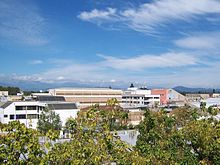
The commune of Linares covers an area of 1,465.78 km² and a population of 93,602 inhabitants according to the 2017 census, resulting in a population density of 63.85 inhabitants per km². This total is broken down into 48,931 women and 44,671 men, so the communal masculinity index is 91.29 per 100 women.
Towns of the commune
In addition to the city of Linares, there are two other population entities in the commune that technically have the character of towns, in the 2002 census categorization. They are:
- Vara Gruesa, with 1,619 inhabitants, and
- The Works, with 1,472 inhabitants.
The following population entities whose territory is totally or partially (shared with another commune), within the municipal area of Linares, have been assigned the status of villages:
- Llancanao, 309 inhabitants
- San Antonio, 640
- Maitenes, 649
- Palmilla (Linares)
- Guadantún, 350
- La Posada, 499
- Alto Bridge, 600
- San Antonio Encina, 427
- St. Victor Alamos, 552
- Vega Ancoa
- Embalse Ancoa, 5oo
- El Peñasco, 302
- Vega de Salas, 100
- Pejerrey, 180
Climate
The climate of Linares has well-defined seasons. Average annual temperatures vary between about 20 and 22°C. Summer is consistently dry and winter is usually rainy (the rainiest months are May, June, July and August). The thermal difference between the warmest and coldest month is approximately 13-14°C in Linares, while the daily thermal oscillation exceeds 9°C.
In the province of Linares, precipitation is almost exclusively of frontal origin. Precipitation totals between May and August reach 80% to 85% of the annual total. Between October and March it usually rains less than 10 mm. monthly. In winter, intense snowfall occurs in the mountain range, which constitutes important water reserves for the summer season and defines the development of the river systems in the area.
The annual amounts of precipitation exceed 640 mm in Linares and Panimávida and 2,160 mm in the high mountain range of the province. The average in January is -29°C and in July it is 11°C.
During the 2017 heat wave, the absolute maximum of 42.6 °C was recorded on January 26, 2017.
| Month | Ene. | Feb. | Mar. | Open up. | May. | Jun. | Jul. | Ago. | Sep. | Oct. | Nov. | Dec. | Annual |
|---|---|---|---|---|---|---|---|---|---|---|---|---|---|
| Average temperature (°C) | 29.8 | 28.5 | 25.1 | 20.7 | 15.6 | 12.3 | 12.2 | 14.0 | 17.2 | 20.3 | 23.5 | 23.8 | 20.3 |
| Temp. medium (°C) | 11.9 | 11.4 | 8.7 | 6.4 | 6.5 | 4.9 | 3.6 | 4.0 | 5.3 | 7.5 | 9.0 | 11.6 | 7.6 |
| Total precipitation (mm) | 13.1 | 10.1 | 20.3 | 61.9 | 170.5 | 208.0 | 180.1 | 128.8 | 77.3 | 44.0 | 29.6 | 20.2 | 963.9 |
| Source: MSN 2008 | |||||||||||||
Urban configuration
The urban configuration of Linares is characterized by a historic center made up of the classic and symmetrical blocks laid out by the builders who laid out the urban centers of colonial Chile. Initially, this center was made up of a handful of blocks, located around the Plaza de Armas. Later, this nucleus extended to eighty blocks, according to the grida, or squared grid, typical of the initial urban structure of Latin American cities. In this case, there were ten blocks from north to south, between the current Carlos Ibáñez del Campo and Rengo streets, and eight blocks from west to east, between Yungay street and Brasil Avenue. The Linares railway station is located in the latter. The Plaza de Armas - with the cathedral on its western side - was thus located slightly to the west of the geographical center of this complex. Five blocks of Valentín Letelier Avenue, in which the avenue widens, due to the presence of a central tree-lined platform between both circulation routes, constitute the characteristic Alameda of so many cities and towns in Central Chile.
Independencia Avenue, which runs from west to east for eight blocks, ending at Brasil Avenue and starting from Yungay, as a continuation of the west access route to Linares, is the main street for financial services. from the city. Maipú and Brasil streets look more towards commerce aimed at the rural residents of the area. In the first of those named is the Linares Municipal Market.
The expansion of the city has developed towards the four cardinal points. Towards the east of the railway, early in the development of Linares, the populated and popular neighborhood known as 'Población Oriente' grew, which currently almost reaches the original core of the city in surface area. More recently, the city has grown considerably in its northwest corners - with developments oriented more towards the middle class - and southeast, with popular populations. The south, and particularly the southeast of the city, is already reaching the banks of the Ancoa River. The north side has developed somewhat less, in terms of built area, but has been characterized by witnessing the construction of condominiums and high-cost homes, some of them surrounded by land that was originally agricultural and now converted into plots. of pleasure". This trend is occurring mainly along the roads to Yerbas Buenas and Colbún.
Access routes
Roads
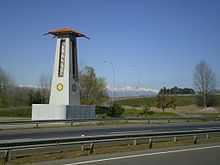
Route 5 South (Ruta del Maule concession) passes three kilometers west of Linares. A wide avenue three kilometers long, called Aníbal León Bustos, connects Route 5 South with the city center. This artery connects the access to the city with the main commercial street of the commune. Other paved roads that connect Linares with neighboring places are: the route to Yerbas Buenas, the road to Panimávida and Colbún, the road to San Juan and La Floresta (which starts from the previous one), the road to San Antonio, and the modern road to Palmilla, Marimaura and Melozal, which crosses the Loncomilla River through a modern bridge.
Railway
Linares station is a regular stop for the Chillán-Estación Central Train service, which runs between Santiago and Chillán. From March 2010 to April 2011, rail service was suspended as a result of the damage caused by the 2010 Chile Earthquake.
Currently there are 3 trains in each direction that stop in Linares.
As of Monday, September 24, 2012, the new service began "Maule Rural Express", Santiago, Curicó, Talca, Linares and vice versa with a UT-car 440 Metrotrén. The train leaves for the capital from Monday to Friday at 6:45, arriving there at 10:15 and returns from Santiago at 17:30, arriving in Linares at 21:00. The "Maule Rural Express" is designed to be a faster alternative to buses (only 3 and a half hours of travel versus 4:10 for buses) and also cheaper, since the ticket only costs $3500 between Linares and the Capital.
Buses
The commune has 4 bus terminals and will soon inaugurate a fifth terminal that will be located at the entrance to the city, giving priority to international buses that generally do not enter the city.
- Terminal Rodoviario y Rural Bravo y Najle de Linares (January Espinoza N°530)
- Terminal Pullman Bus Los Libertadores (Yungay corner Independence)
- Linatal Terminal (Avenida Aníbal León Bustos N°230)
- Terminal Rodoviario San Ambrosio (January Espinoza, between streets Gral Barbosa and Carampangue)
And of which you can make trips to cities such as: Santiago, Talca, Parral, Chillán, Concepción, Curicó, Los Ángeles, Temuco, Rancagua, Longaví, Curanipe and Cauquenes.
Economy
Linares is an important regional agricultural, industrial, commercial, financial, distribution, transportation and services center.
In the local economy, inaugurated in 1958, during the second half of the century XX the branch of the National Sugar Industry (Iansa), was considered the main communal industrial entity, producer of beet sugar, providing direct and indirect employment in its best time to about 20,000 people, and in recent years to about 4,000 people, until its definitive closure in 2018.
Tourism is also being motivated, which in this area can be quite strong due to its foothills.
Given the favorable climatic conditions and good natural irrigation, the rural sectors of the commune of Linares gravitate towards agriculture, highlighting cereal crops such as rice, wheat, corn and oats, and vegetables, such as beets, cabbage, lettuce and chard and legumes such as beans.
Fruit production (fruit trees, kiwi, berries) is also important and has been an essential item in the provincial and local economy in the last two decades. An important part of this production is destined for export. Linares is the main rice-producing province in Chile; In fact, 78% of the national production of this cereal occurs in this province, especially in the commune of Parral. There is also incipient forestry towards the east of the province, as well as in areas of the Coastal mountain range.
Wine production in the province of Linares constitutes one of the most important sectors of the provincial economy, especially in the communes of San Javier and Villa Alegre.
As for livestock, the raising of cattle, horses and pigs stands out.
In 2018, the number of companies registered in Linares was 2,097. The Economic Complexity Index (ECI) in the same year was 0.84, while the economic activities with the highest Revealed Comparative Advantage index (RCA) were Forage Crops in Improved or Seeded Grasslands (62.9), Cultivation and Collection of Mushrooms, Truffles and Sap, Production of Maple Syrup and Sugar (27.72) and Cultivation of other Oilseeds (22.22).
Education
School education
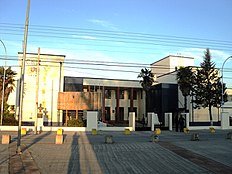
Among the Linares school establishments, the following can be mentioned:
- Municipalities
- Liceo Bicentenario Valentín Letelier Madariaga (formerly called Liceo Juan Ignacio Molina or Liceo de Hombre)
- Liceo Politécnico "Ireneo Badilla Fuentes".
- Technical Liceo "Diego Portales" (former School 3).
- Instituto Comercial (ex Liceo de Niñas)
- F-467 School "The Lions".
- Maipu School (former School 1).
- E-453 (former School 2).
- E-480 School "Santa Barbara".
- Escuela Ramón Belmar Saldias
- Particulars
- Alborada College.
- Conception College.
- Amelia Troncoso College.
- Lucila Godoy College.
- San Sebastian College.
- Gabriela Mistral College.
- Cordillera College.
- Marcela Paz College.
- Colegio Prospero Villar Bravo.
- Manuel Bulnes College.
- Javiera Carrera Educational Institute.
- Letelier Valentine's Institute.
- Religious unit
- Instituto Linares (Marianist Congregation)
- Providence (Brothers of Providence)
- Liceo María Auxiliadora (Religiosas Salesianas)
- Fundación Educacional Liceo Nuestra Señora del Rosario (Religiosa Mercedarias)
- Colegio San Miguel Arcángel (Catholic)
- Don Bosco Agricultural School (Salesians)
- Adonay College (Protestant churches)
- College Conception (Frankmasonry)
Higher education
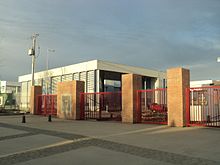
Linares until a few years ago housed the headquarters of two private universities: the Bolivarian University (Sede Maule) and the University of Aconcagua, currently removed from the city. In addition, until 2008, there was a headquarters of the Universidad La República, created in 2004, which after the bankruptcy of the aforementioned study house was acquired by the Pedro de Valdivia University, which decided to permanently close the headquarters due to lack of expectations.. In 2014, the state University of Talca was reinstated with two professional and three technical degrees. There are also several technical training centers in the city.
In the past, there were some attempts to bring a headquarters of the University of Chile to the city, which failed. Later, the two Maule universities unsuccessfully promoted campuses in Linares. The University of Talca installed its headquarters next to the current Valentín Letelier high school between 1984 and 1985, while the Catholic University of Maule did something similar in the 90s in various homes.
In 2012 the University of Talca announced its return to the city, planning a campus in the eastern sector that began construction in 2014 to be inaugurated in 2016. While the construction was being carried out, said study house temporarily operated in a building annex to the Diego Portales High School.
In 2014, the Autonomous University of Chile established one of its clinical campuses in the city, dependent on the Talca headquarters, in agreement with the city's Base Hospital.
Likewise, the city has three privately owned technical training centers: Massachusetts, Salesianos and San Agustín.
In 2016, the law that created 15 state-owned CFTs established that the one corresponding to the Maule Region would have its headquarters in Linares. In 2018 the Maule CFT came into operation, whose provisional headquarters are located in offices attached to the Polytechnic High School of the city.
Culture and society

Art Cultivators
The city of Linares throughout its history has received and receives important figures of national culture. Likewise, other great exponents have emerged within it.
Among the cultists originally from Linares, it is worth highlighting the writer and journalist Januario Espinoza, who stood out as an essayist, poet and novelist. Today, one of the main streets of the city is named after him. Nor should we forget Julio Chacón, who rescued communal history, and Edilberto Domarchi, poet and professor. The lawyer and rector of the University of Chile, Mr. Valentín Letelier, should not fail to be mentioned either, who, although his emphasis was placed on education, also made his contributions in literary and documentary matters. More recently, the great contribution of the folklorist Margot Loyola, recognized nationally and internationally, and the talent of the writer and academic Gustavo González Rodríguez should be highlighted.
Among those outsiders who contributed to the culture of Linares, we can mention Samuel Maldonado Silva (1916-1988), who at the age of 21, in 1939, arrived in Linares as a columnist for the newspaper El Heraldo, the medium of which he would become to be a press director, training a generation of journalists, in times when there was no university degree. Later, he would found the newspaper Sucesos, several magazines; he published novels and books of poetry; He was one of the pioneers who founded the College of Journalists of Chile, which allowed the accreditation of an entire generation of journalists. He was Regional President of the union for many years. In his last years he served as press director of Radio Soberanía, where he was a teacher of a true school of young talents. In 1985 he received numerous decorations for his 50 years of notable contribution to the city's journalism. In the field of arts, together with Manuel Francisco Mesa Seco, Inge Linz and Pedro Olmos, they founded the Ancoa Group, which was an important promoter of local culture. In 1965 he founded the magazine ANCOA Collections.
The writer, poet and language academic Manuel Francisco Mesa Seco, born in Constitución, and who became provincial Governor, lived in Linares for most of his fruitful life. Poet, short story writer, playwright, literary critic, essayist, public servant, lawyer, councilor, governor and literary ambassador of the Maule River and its region, Mesa Seco was one of the great writers of Chile. A very prolific author, he was the first writer from the provinces to sit in the chairs of the Chilean Academy of Language. Of the many poets of the Maule Region, so prolific in poets and singers of the human and the divine, Mesa Seco was perhaps the most identified, organically, with the nature of the "river of mists".
Also settled in Linares, a place that was the recipient of an important part of his exceptional artistic work, Emma Jauch (born in Constitución) and Pedro Olmos (born in Valparaíso), a couple gifted like few others with truly Renaissance artistic spirit and talent. Emma, poet, writer and painter, and Pedro, painter and muralist, made Linares their home and filled it with color and warmth for more than thirty years. His absence - both died in the '90s - has left a void that is felt every day.
Museums
- Museum of Art and Crafts. It was founded on 12 October 1966 and its collections were formed thanks to the generosity of national artists who gathered more than 200 works of art, covering a century of national plastic production (1880-1980), and also to the contributions made by the National Historical Museum and the National Museum of Fine Arts. The museum periodically performs temporary exhibitions of visual arts and popular crafts, poetic recitals, conferences, folklore workshops, literature and plastics, and documentary and film video cycles. The museum is an important cultural space open to the entire community.
Zoos
- Casa Noé Mundo Animal. Casa Noé Mundo Animal is a zoological park and rehabilitation center for exotic and wild fauna, located in the city of Linares, Chile, where ecological and environmental values are taught generating awareness and transmitting the message of protecting the biodiversity of animal species and caring for the environment.
It began in 1975 in a private manner and opened its doors to the public on October 4, 2002. Its transfer to the new premises began on April 4, 2012 and opened to the public on July 15 of the same year.. It all begins with the love for animals of its Director, Don Juan Carlos Muñoz Escobar, a native of the city of Linares, who as a child began to shelter injured and sick animals in his home, caring for them and providing them with a better quality of life. The Casa Noé rehabilitation center has cared for a wide variety of exotic and wild animals which are rescued by the Agricultural and Livestock Service (SAG) as well as by Carabineros de Chile officials and private individuals. The animals that can be rehabilitated are returned to their environment after being treated and cared for by professionals. In some cases it is impossible for them to return to nature as a result of their physical problems, therefore they are kept in the Zoological Park, taking advantage of their stay for research. and education. The new Casa Noé facilities are located in San Antonio, aerodrome sector and have sectors of aquatic environments, reptiles, ornamental birds, day and night birds of prey, arachnids, primates, rodents, amphibians, camelids, canines, felines, patio food for visitors, ample parking and nightlife.http://casanoe.net/
Media
Throughout its history, in Linares there have been several and varied written media, with the newspaper La Idea, created in 1871 by Nicomedes Pincheira, being the first to be founded in the city.
Today, Linares is one of the few cities in the country to have more than one newspaper of its own. The traditional newspaper El Heraldo, founded in 1937 by Justo Aliaga Cobo, is currently joined by El Lector, founded in 1997.
Another written medium is the Linares Magazine, it is possibly the oldest medium that is still published in the Province of Linares. Until 1973 in traditional paper publication; and, currently, in a careful digital edition. Its paper version is delivered to all businesses in Linares.
As for radio stations, the first to be founded was Radio Soberanía (CC 152) in 1938, reopened in 1949 and ending its transmissions in March 2011. The oldest station in operation is < i>Radio Ancoa (CC 116), founded in 1975 and which in 1996 inaugurated its FM broadcasts.
In the modulated frequency, the pioneer in the city was Radio Ambrosio, founded in 1978 (currently on the 90.7 dial).
Other important radio stations are: Buena Nueva, Innovadora (originally founded as Contigo), María, < i>Radio Tropical Latina 95.3 FM (subsidiary of its namesake from Curicó).
Since 2002, Linares has had an open television channel, called TV5 de Linares, originally Regional Television, which operates on VHF frequency 5.
Since 2007, Discover Linares was launched, the first website on tourism, nature and culture in the commune and province of Linares.
Places of interest
Religious buildings
- The Church-Cathedral of Linares de Diocese de Linares. This temple is one of the most beautiful churches built in Chile in the 20th century AD. It was conceived based on the model of the Basilica of San Ambrosio, in Milan, a noble construction of Romanesque style. The Cathedral of Linares was built after the destruction of the old cathedral, due to an earthquake. Who conceived the new Cathedral and began his works was the visionary Bishop of Linares, Mons. Juan Subercaseaux Errázuriz, second bishop of the diocese. It preserves the mortal remains of Pope St.Clement, being the only Pope whose remains are preserved outside of Europe. With the earthquake of 27 February 2010, the Cathedral Church suffered damage that could be seen from the outside of the temple, mainly bricks that fell from its main tower and the fall of the cross that was located in the center of the building. However, according to later studies carried out by experts, the Cathedral Church does not present structural damage, so prior to a repair, it will reopen its doors to the linarense community.
- The parish church Heart of Mary created by the architect Diego Hernández Muñoz. A church declared a National Monument for its beauty and inspired Gothic style. After the earthquake of February 27, 2010, which struck southern Chile, this temple was severely damaged. Its façade presents significant damage; in addition one of its two lateral towers was fractured and bowed to the interior, having to be removed and later covered mind. The church until today[chuckles]When?] remains closed and its surroundings evicted.
- The Evangelical Cathedral, which is the central temple or matrix of the organization United Methodist Pentecostal Church at the national level, bears by name Christ Manantial of Life, located in Arturo Prat street corner Maria Cristina, stands out for its modern style. His pastors are Rev. Bishop Juan Ormeño Lagos and his diaconous wife Alicia Parada Acuña.
Civil buildings
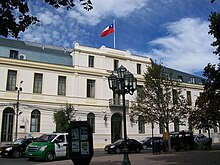
- Presidential Delegation Building: neoclassical art building, built at the beginning of the centuryXX.. Among other things, the Provincial Intendence, the Prison and the City Courts of Justice worked. In 1990 he suffered a fire, but was rebuilt in 1993. Today the Provincial Government, the Provincial Social Economic Council and the Municipal Library operate there.
- Municipality Building: in front of the Plaza de Armas, in the corner of Kurt Moeller with Manuel Rodríguez. It was opened in 1931. Inside there is a mural painted by Pedro Olmos where the main characters of linarense history appear. Neoclassical style.
- The Municipal Market: works on Maipú Street, between Chacabuco and Benjamin Novoa. One of the city's main supply centres houses both vegetable and agricultural stalls.
- Other buildings: Also outstanding are the Posts Building (in front of the Municipality), the Liceo Valentín Letelier (inaugurated in 1949 right on the site where Valentin Letelier was born), the firehouse (with its characteristic tower), among other buildings.
Artillery School
In the city of Linares is the Artillery School of the Chilean Army. In 1911, the city of Linares offered the then Government the necessary land to build a Military Barracks, which later, under the mandate of President Arturo Alessandri, the Artillery School was definitively created. This armed institute's mission is to train future Officers, Non-Commissioned Officers, Artillery Weapon Classes, Anti-Aircraft Artillery and specialists in Aerial Observation of Artillery Shooting, both in the Technical-Operational and Scientific area, as well as in the doctrinal use of the means of the Weapon in its different calibers, teaches the doctrine of the Gunners and supervises its compliance, reviews and keeps the regulations of the Weapon updated.
Plazas and parks

The main place for walking in the city is its Plaza de Armas, where the main streets of the commercial and civic center of the city converge. In front of it are located the Municipality, the Provincial Government and the Cathedral, some of the main banks - Estado, Santander, BCI, Scotiabank -, and the criminal courts.
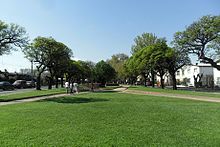
The other important green place in the city is its Alameda, which is located on Valentín Letelier Avenue, between San Martín and Lautaro, made up of several blocks of trees and bushes, which have the Valentín Letelier High School as a closing frame. The House of Culture is located on this road (in the former Bus Terminal) and opposite are the Museum of Art and Crafts, the Carabineros Prefecture, the Prison and the Fire Station.
Other important green areas of the city are Plaza Víctor Jara (Valentín Letelier, corner Januario Espinoza) and Parque Carlos Aburman En Januario Espinoza (in front of EASY) - and General Cristi Park (on General Cristi Avenue, with the Municipal Gym on the corner with Rengo).
The Plaza Presidente Pinochet also stands out next to the Artillery School, on Avenida Presidente Ibáñez and Chacabuco, dating back to September 11, 1991.
Natural and tourist environment
Linares has natural attractions in its surroundings, as well as in the adjacent communes, which include the hills of the foothills, and the mountain range, with pine forests; lakes (mainly the Colbún reservoir and artificial lake); rivers, and excellent options for hikers and camping. They present very attractive places: the Melado River (commune of Colbún), the Pejerrey estuary and the Achibueno and Ancoa rivers.
The rivers in the area, especially the upper reaches of the Ancoa and Achibueno, present excellent opportunities for descent in an individual canoe (canoeing or kayak) through the white waters of both, as well as for rafting, that is, collective descent on rafts. through rapid and steep slopes with whitewater currents. Likewise, mountaineering in the surroundings is an attractive possibility, as is recreational fishing, horseback riding and hiking, that is, walks that can last several days, through the mountains and natural spaces of this beautiful area.
The El Melado mountain sector offers various natural attractions, especially for fans of adventure tourism and ecological tourism. It is possible to see ravines, native forests, petroglyphs, lagoons, the Cordón de El Melado and other places of exceptional beauty. The Los Bellotos National Reserve stands out, where it is possible to see the southern acorn (a species in danger of extinction), the coigüe, the Cordillera cypress, the maulino oak, the quillay, the liter, the peumo and the hazelnut.
Among the fauna of the place, the condor, the tricahue parrot, the eagle, the peregrine falcon, the tiuque, the black woodpecker and the chercán stand out.
In the El Melado sector is the tunnel that receives the waters of the Melado River and is a great work of Chilean engineering, 4,200 meters long, built between 1918 and 1926 and located in the sector. of Stoves.
To the Colbún S.A. reservoir. It is accessed by a dirt and gravel road that starts from the paved road that goes from Linares to the town of Colbún. Thus, you can even reach the Canal Melado tunnel, passing through the Ancoa and Roblería Reservoir area, in a route of approximately 55 km. The reservoir, whose surface area is 417 hectares, and with an altitude that ranges between 1,300 and 2,010 meters above sea level, is located in the foothills of the province of Linares.
In the commune of Colbún are the well-known thermal complexes of Panimávida and Quinamávida, and the town of Rari, with its distinctive and unique horsehair crafts.
Sports
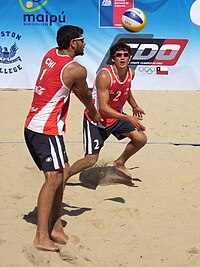
In sports, Linares has stood out for Volleyball, having a men's team seven times champion of the Chilean Volleyball League. In 2008, the local men's team won the Chilean National Volleyball Championship, after beating the Universidad Católica team in the final. In 2009, the Linares volleyball team became two-time champion by beating VitaVolley-Manquehue 3 sets to 0.. Linares once again consecrated itself in 2011 where it defeated Club Manquehue 3-1 in a regular match with scores of 18-25, 26-24, 25-22 and 25-16 and then won the “golden set” of the final by 25-16.
The sextet manages to win its second Bi-Championship by winning the 2013 and 2014 tournaments led by Jaime Grimalt Suárez. Linares defeats the Thomas Morus team in the final on both occasions.
The city of Linares has hosted the 2012 South American Men's Volleyball Club Championship.
And the city team has managed to win the title of the highest category of national volleyball 9 times, being champion for the last time in 2019 of the A1 league, beating the Santiago team Thomas Morus in the final. Furthermore, in 2019 the Linares under-19 team managed to win the National Volleyball Championship in Río Bueno. Those led by Cuban Juaquin Planas won undefeated, showing the best youth volleyball in the country.
In beach volleyball, the Linares duo of Marco and Esteban Grimalt managed to become champions of the 2009 Telmex Cup tournament held in Viña del Mar. Both athletes will participate in the 2010 South American Games in Colombia, where they won a bronze medal. The Grimalt team finished 2014 in a brilliant way, demonstrating great level and maturity, obtaining the silver medal at the FIVB Manguang Open in South Africa. The duo won a bronze medal at the South American beach volleyball tournament held in Coquimbo in February of 2015, after beating the Brazilians Fabio Bastos and Saymon Santos by 21-16 and 21-13.
Linares, historically, has lacked major successes in football, despite which he has stood out in some amateur championships. The main soccer team in the city is Deportes Linares, known in ancient times as Lister Rossel, which played for several seasons in the Second Division of Chilean professional soccer. It plays at the Linares Municipal Stadium, the city's main sports venue, and at this time the team is playing in the second division tournament.
Club de Rugby Weichafe de Linares, usually known only as Weichafe, is the city's rugby team.
On November 7, 2020, the Club Deportivo Hockey Linares (field hockey) was founded. The club was born as an initiative of residents of the nascent Villa Huertos de Linares and its training sessions take place at the Fiscal Stadium in Linares.[citation required]
Motorcycling
Thanks to its steep foothills, Linares has several Enduro circuits, on hills such as Rayo and Alto el Nabo. The Baqueanos enduro group is established in this city, highlighting the pilot Manuel Gallardo, former national enduro champion. [citation required] On the other hand, Jaime Armengoli, currently living in this city National champion of the Master B category and the outstanding Valdivian pilot Juan Pablo Navarro.[citation required]
Administration

Mayor and Presidential Delegate
The Presidential Delegate is María Claudia Jorquera and the mayor of the commune of Linares is Mario Meza Vásquez, who belongs to RN.
Scandals in municipal management
In 1969, Mayor Héctor Pinochet Cuello was assassinated on the way out of the municipality after a tense Council session.
Currently the PDI Economic Crimes Brigade is investigating the municipality for embezzlement of funds and falsification of public instruments.
The Comptroller's Office also issued a report detecting costs for purchases of chlorine and antigen tests for $73 million pesos.
Community Council
The municipal councilors of Linares are:
- Christian González (RN)
- Cinthia Labraña (RN)
- Favio Vargas Aguilera (RN)
- Carlos Castro Romero (RD)
- Jesus Rojas Pereira (DC)
- Eduardo Corvalan Verdugo (PC)
Media
Radio stations
- FM
- 88.1 MHz Radio Maria Linares
- 88.9 MHz Radio Pudahuel
- 90.7 MHz Radio Ambrosio
- 91.3 MHz DNA Radio Chile
- 93.1 MHz Heart FM
- 94.7 MHz Radio La Mexicana
- 95.3 MHz Radio Tropical Latina
- 95.7 MHz Radio Ancoa
- 96.3 MHz Radio Cristalina
- 97.9 MHz Radio Buena Nueva
- 99.9 MHz Radio More (Longaví)
- 101.1 MHz Radio Carolina
- 103.5 MHz Radio Frequency One
- 104.1 MHz Innovative Radio
- 106.7 MHz Radio Armonía
- 107.1 MHz Radio Amparo
- 107.3 MHz Radio Nuevas de Gran Gozo
- 107.5 MHz Radio Juan Pablo II Linares
- 107.7 MHz Radio San Antonio de Padua Linares
Television
The television channels transmit from Cerro La Virgen de Talca with the exception of TV5 Linares.
- VHF
- 4 - Chilevision
- 5 - TV5 Linares
- 8 - Channel 13
- 10 - TVN (transmits the signal of the National Television of Chile Red Maule)
- 12 - Mega
- TDT
- 5.1 - TV5 Linares HD
- 5.2 - TV5 Linares HD2
- 5.3 - Ancoa TV
- Cable
- Linares Channel 2 (issued by VTR Chile)
- Channel 30 Linares (issued by Multicom Maule)
- TV5 Linares (emitted by the World)
Written press
Since August 29, 1937, El Heraldo newspaper has been printed. In 1998 the newspaper El Lector was created, in addition to the circulation of the regional newspaper La Prensa de Curicó.
Digital press
- Diario Maule
- Publinars
- Online Linares
- Maule To Day
- Seventh Page
- Maule Virtual
- Now Linares
- Time 7
Cities of the same name
Famous people
Contenido relacionado
Cartagena
Plaka
Solifluction